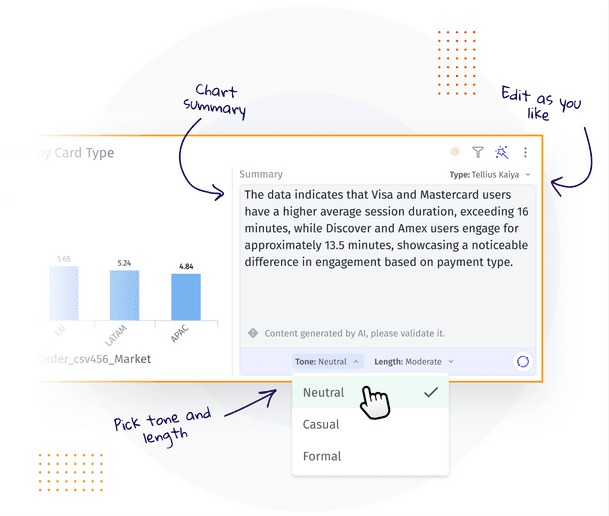 Custom SEO Strategy – Your Path to Page #1 Starts Here!
Custom SEO Strategy – Your Path to Page #1 Starts Here!
How GPT Analytics is Revolutionizing Data Interpretation and Reporting
Written by Tellius » Updated on: June 17th, 2025

In today’s data-centric world, the ability to interpret and report on vast amounts of data quickly and accurately is crucial for business success. Traditional data interpretation methods often involve complex processes and manual effort, which can lead to delays and inaccuracies. Enter GPT (Generative Pre-trained Transformer) analytics—a transformative technology that is revolutionizing how data is interpreted and reported. By leveraging advanced natural language processing (NLP) capabilities, GPT analytics is reshaping the landscape of data analysis and reporting.
What is GPT Analytics?
GPT analytics utilizes GPT models, which are a type of artificial intelligence (AI) designed to understand and generate human-like text based on vast amounts of training data. These models can process and analyze text data, providing insights and generating reports with a level of sophistication previously unattainable. The key advantage of GPT analytics is its ability to interpret complex data sets and present findings in a natural, human-readable format.
Enhancing Data Interpretation
Natural Language Understanding: One of the most significant advancements brought by GPT analytics is its ability to understand and generate natural language. Traditional data interpretation often involves translating raw data into meaningful insights manually. GPT models can automatically interpret data and produce comprehensive summaries, making it easier for users to understand complex information without needing deep technical expertise.
Contextual Insights: GPT models excel at providing contextual insights. By analyzing data in relation to its broader context, these models can identify patterns, trends, and anomalies that might be missed through traditional methods. This contextual understanding enables more accurate and nuanced interpretations of data, leading to better decision-making.

Automated Analysis: GPT analytics can automate many aspects of data interpretation. For example, rather than manually sifting through large data sets to identify key metrics, GPT models can quickly highlight important findings and generate relevant insights. This automation reduces the time and effort required for data analysis, allowing businesses to respond more swiftly to emerging trends and issues.
Transforming Data Reporting
Dynamic Report Generation: Traditionally, generating reports can be a time-consuming process involving numerous manual steps. GPT analytics streamlines this process by automating report generation. Users can input specific queries or criteria, and GPT models will produce detailed reports in a natural language format. This dynamic reporting capability ensures that reports are not only accurate but also easily understandable.
Customizable Reporting: GPT analytics allows for highly customizable reporting. Businesses can tailor reports to meet specific needs, such as highlighting certain metrics, comparing data sets, or focusing on particular trends. GPT models can adjust the content and format of reports based on user preferences, providing a more personalized and relevant reporting experience.
Enhanced Communication: Effective communication of data insights is crucial for decision-making. GPT analytics improves communication by generating clear, coherent, and actionable reports. These reports can be easily shared with stakeholders, ensuring that everyone involved has a clear understanding of the data and its implications.
Practical Applications and Benefits
The impact of GPT analytics on data interpretation and reporting is profound. In sectors such as finance, healthcare, and marketing, GPT models are being used to analyze market trends, patient data, and customer feedback with unprecedented efficiency. For instance, financial analysts use GPT analytics to quickly generate investment reports and forecasts, while healthcare providers use it to interpret patient data and improve outcomes.
The benefits of GPT analytics are manifold. By automating data interpretation and reporting, businesses can save time, reduce errors, and enhance the accuracy of their insights. Additionally, the ability to generate natural language reports makes data more accessible to a wider audience, facilitating better communication and collaboration.
GPT analytics is revolutionizing data interpretation and reporting by leveraging advanced natural language processing capabilities to make complex data more accessible and understandable. Its ability to automate analysis, provide contextual insights, and generate dynamic reports is transforming how organizations approach data. As businesses continue to embrace GPT analytics, they can expect more efficient data handling, improved decision-making, and enhanced communication of insights. In a world where data is increasingly critical to success, GPT analytics represents a significant leap forward in the evolution of data analysis and reporting.
Note: IndiBlogHub features both user-submitted and editorial content. We do not verify third-party contributions. Read our Disclaimer and Privacy Policyfor details.
Copyright © 2019-2025 IndiBlogHub.com. All rights reserved. Hosted on DigitalOcean for fast, reliable performance.














